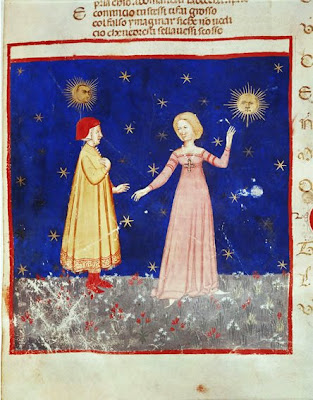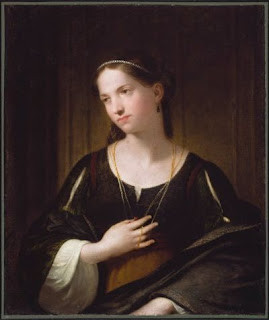 |
| Dante and Beatrice, 15th century |
Today I'd like to see what we can figure out about the real woman behind Dante's inspiration and muse, the beautiful and otherworldly Beatrice. She was the focus of Dante's adoration from a distance, his beloved - his lady, in the parlance of the medieval culture of courtly love.
- But first, one quick announcement: I've recently added a "follower" thingie up on the top right corner of this blog, and if you're someone who visits here from time to time, I hope you'll choose to follow it. I probably should have enabled this at the outset, but I didn't, and now I'm trying to catch up. Thank you.
 |
| Please follow this blog... |
Returning you now to your regularly scheduled blog post, we were about to talk about Beatrice.
Often I find myself staring at a mass of dry facts - dates and names and incidents - and sifting through them as I search for the human beings in the factual record. Searching for the story.
But in the case of Dante's Beatrice, "the glorious lady of my mind," as he called her, it's the other way around. We know next to nothing about the historical woman, yet her name endures in legend, in art, in music, in poetry. A particular favorite among 19th century romantics, as you can see from the art in the rest of this post, poor Beatrice is awash in sentimentality. I suspect this would have left a young medieval Florentine woman bemused, at best.
 | ||
| Marie Spartali Stillman, 1895 |
But we don't know with certainty that she even existed. There have been scholars who insist that she is wholly allegorical, or metaphorical, or some such thing. Most, however, seem to accept the word of Dante's son Pietro and of Giovanni Boccaccio that Beatrice was indeed a real woman: Beatrice, usually known as Bice (that's BEE-chay, rhyming with eBay, not with mice, lice, or rice), the daughter of Florentine banker and philanthropist Folco Portinari. (Her full name would be pronounced Bay-ah-TREE-chay. Not that these phonetic renditions capture the vowels properly, but you get the general idea.)
 |
| Washington Allston, 1819 |
Pietro Alighieri tells us that Bice is of the Portinari family, and Pietro should have known. He was one of the first commentators on his father's work. It seems unlikely to me that he would have erred in this.
As for Giovanni Boccaccio, author of The Decameron and early Dante scholar, he tells us that Bice was the daughter of Folco Portinari. Boccaccio was only eight years old when Dante died in 1321, but he did his research well. He was acquainted with Andrea Poggi, Dante's nephew (son of Dante's sister, whose name we don't know, and her husband Leone Poggi, a bannitore or town crier), who was said to look remarkably like the poet; also, Boccaccio's stepmother Margherita Mardoli was a cousin of Bice's.
 |
| Dante encounters Beatrice, Henry Holiday, 1883 |
 |
| Poul S. Christiansen, 1895 |
Folco, in addition to serving his city as an elected official, was a generous supporter of many charities, including his parish church of Santa Margherita, but he is perhaps best known and remembered for founding the hospital of Santa Maria Nuova, which is still operating in Florence today. His family provided the hospital's main financial support for several generations after Folco endowed it in 1288.
Some say that Folco was given the idea by a servant, one monna Tessa, who is sometimes described as Bice's nurse. Some have even said that he founded the hospital in self-defense, because his servant kept bringing sick people home and installing them in his house so she could care for them. Monna Tessa, the wife of a saddle-maker named Ture, founded the Order of the Oblates in 1288 while employed by the Portinari. These Third Order women worked in Folco's hospital and in other settings, caring for the ill and the elderly as an act of charity.
 |
| Dante and the friends of Beatrice, Marcel Rieder, 1895 |
Laws designed to curb the lawlessness and fractiousness of the magnates began to be passed in the 1280s, and continued through the famous Ordinances of Justice in 1293, by which time magnates were barred from holding public office, required to post monetary bonds against the potential bad behavior of their families, and severely penalized if they caused harm to one of the popolani (the non-magnate population). In 1293, some 72 Florentine families were designated magnates. (A definition of magnate from the 1280s included any house which had had a knight among its members in the previous twenty years, those which public opinion considered to be magnates, and any that had already been so designated by any previous law.) Magnates could be of the nobility, but very wealthy merchants who emulated the behavior of the nobles, such as the Bardi family into which Bice married, could also be so designated. (I keep a list of these families on my refrigerator for quick reference, and yes, they are indeed my refrigerator magnates.)
.jpg) |
| Gustave Doré, 1857 |
.jpg) |
| Carl Wilhelm Friederich Oesterly, 19th century |
 |
| James Blake, 1800 |
There exists some doubt about which Simone she wed (since the Bardi seemed to have several Simones in every branch and every generation), but there is substantial agreement that it was Simone son of Geri, and that he was a knight and a man who served more than once in high elected office in Florence.
 |
| Andrea Pierini, 1853 |
What about Bice's friends? We know from Dante's poems and commentary that she had a friend called Giovanna, nicknamed Primavera ("Springtime"), who was the ladylove of Dante's "first friend" Guido Cavalcanti, a poet and nobleman (yes, from a magnate family). Another woman associated with Primavera and Bice in a poem was Lagia, the ladylove of another poet, Lapo Gianni.
And it seems distinctly possible, even probable, that Bice knew the young woman who was to become Dante's wife - Gemma Donati (the Donati were the magnates to end all magnates). They were neighbors, they were more or less the same age, and Florence was not such a big city, nor its young women so protected in those years, that the two would not have known one another. They may have spent time together; they may have been schooled together; they certainly attended the same small parish church.
 |
| Philipp Veit, 1817-1827 |
And that's what I've been able to learn. So little, really. Over 700 years ago there lived in Florence a young woman known to everyone as Bice. She came from a large and wealthy family, she married young, she died young. She may have been beautiful. She certainly was, to one young poet who has made her immortal.
Images in this post are in the public domain by virtue of more than a century having passed since the deaths of their creators.
4 comments:
The best summary of Beatrice Portinari I have found on the web. Thank you for assembling both the details and the broader social context of this very consequential historical figure, and including some humor along the way. (Are you marketing your Florentine refrigerator magnate lists?)
I would push reasonable speculation a bit further: you mention Folco Portinari supported several charities, and his aide Monna Tessa was involved with staffing one such charity, the hospital, still in operation after all these years. Might some of the strength of character evident in Folco and Tessa have been instilled in Bice and seen by Dante as everlasting virtue? The Comedy is inexplicable as Dante throwing a backwards kiss at a (dead) girl he liked the looks of. According to Dante, Beatrice managed to re-right and rewrite his life, even after her death.
Thank you! I believe you are right that Beatrice must have been a remarkable woman, to have had such a profound effect on someone like Dante (not that there is anyone else like Dante) over so many years. There must have been more to her than physical beauty, certainly. Even in the Vita Nuova - and even more, as you mention, in the Commedia - Dante clearly sees her as something much more than a pretty girl. (And I like "re-right and rewrite" a lot, by the way.)
This post is from so long ago that I had quite forgotten about the refrigerator magnates! Thanks for the memory.
Thank you so much for your research!
I am writing a novel (fiction) that touches on Dante and Beatrice/Bice - and want it to be plausible within what we know about their life. I remember reading that one of her brothers communicated (was friends with) Dante - was it Manetto or Ricovero? Do you know?
Dante scholars seem to agree that it was Manetto, who Dante describes in La Vita Nuova XXXII as his second friend (first being the poet Guido Cavalcanti). I don't know exactly how they came to that conclusion, but I haven't run across any disagreement about it. In VN Dante says that this friend asked him to compose a poem about the recently deceased Bice, and he did so.
I hope to read your novel someday!
Post a Comment